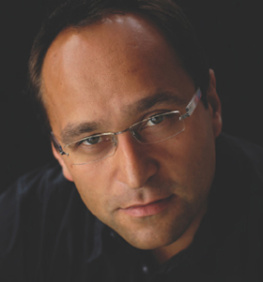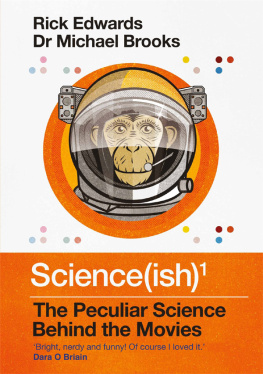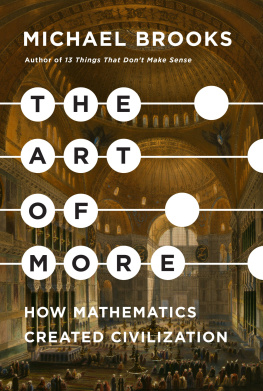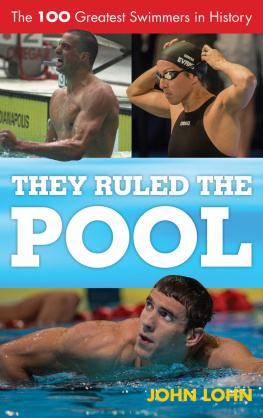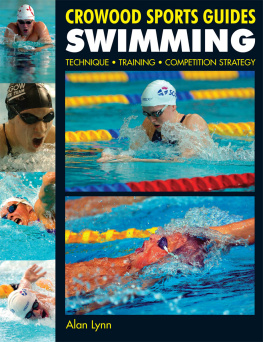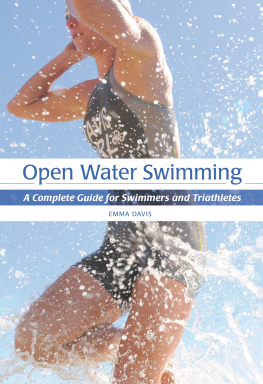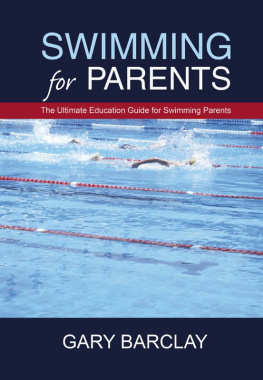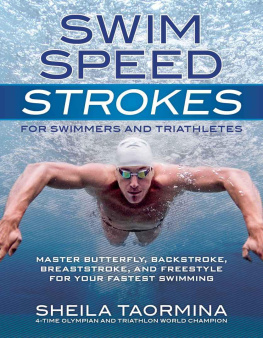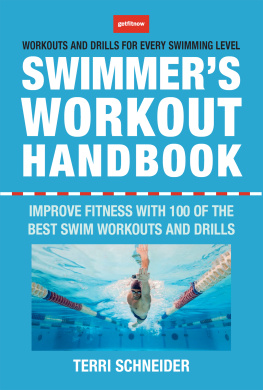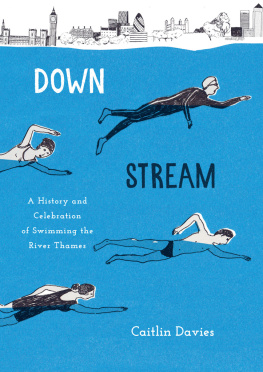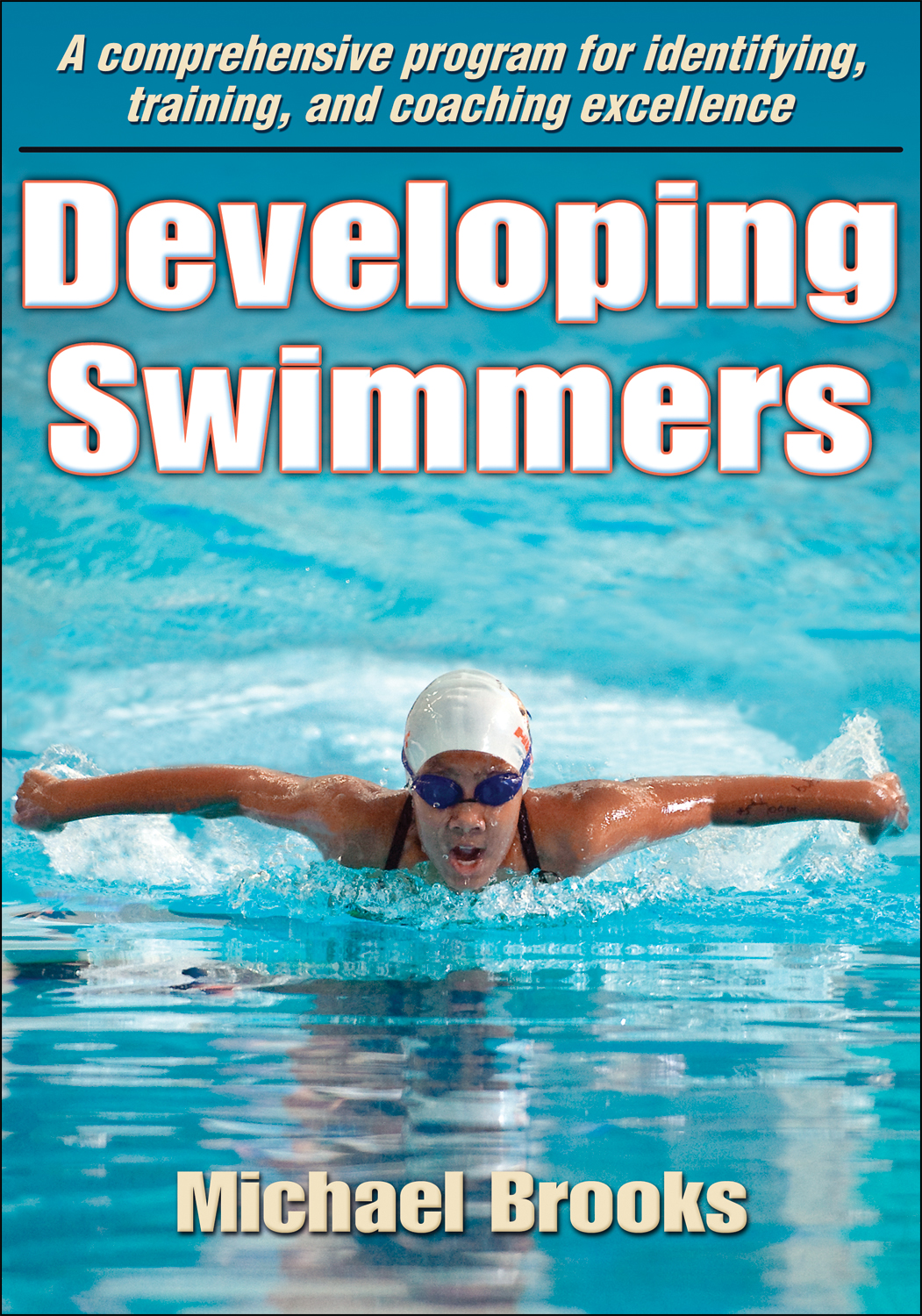Contents
Guide
Pagebreaks of the print version
Developing Swimmers
Michael Brooks

Library of Congress Cataloging-in-Publication Data
Brooks, Michael, 1964
Developing swimmers / Michael Brooks.
p. cm.
Includes index.
ISBN-13: 978-0-7360-8935-7 (soft cover)
ISBN-10: 0-7360-8935-7 (soft cover)
1. Swimming--Training. I. Title.
GV838.67.T73B76 2011
797.21--dc22
[B]
2011006525
ISBN: 978-0-7360-8935-7 (print)
Copyright 2011 by Human Kinetics, Inc.
All rights reserved. Except for use in a review, the reproduction or utilization of this work in any form or by any electronic, mechanical, or other means, now known or hereafter invented, including xerography, photocopying, and recording, and in any information storage and retrieval system, is forbidden without the written permission of the publisher.
Notice: Permission to reproduce the following material is granted to instructors and agencies who have purchased Developing Swimmers: pp. 192, 193, and 194. The reproduction of other parts of this book is expressly forbidden by the above copyright notice. Persons or agencies who have not purchased Developing Swimmers may not reproduce any material.
Acquisitions Editor: Tom Heine; Developmental Editor: Heather Healy; Assistant Editors: Michael Bishop and Tyler Wolpert; Copyeditor: Alisha Jeddeloh; Indexer: Alisha Jeddeloh; Graphic Designer: Bob Reuther; Graphic Artist: Francine Hamerski; Cover Designer: Keith Blomberg; Photographer (cover): Human Kinetics; Photographer (interior): David Haas; Visual Production Assistant: Joyce Brumfield; Photo Production Manager: Jason Allen; Art Manager: Kelly Hendren; Associate Art Manager: Alan L. Wilborn; Illustrator: Human Kinetics; Printer: Total Printing Systems
We thank York YMCA Graham Aquatic Center in York, Pennsylvania, for assistance in providing the location for the photo shoot for this book.
Human Kinetics books are available at special discounts for bulk purchase. Special editions or book excerpts can also be created to specification. For details, contact the Special Sales Manager at Human Kinetics.
Printed in the United States of America10 9 8 7 6 5
The paper in this book is certified under a sustainable forestry program.
Human Kinetics
Web site: www.HumanKinetics.com
United States: Human Kinetics
P.O. Box 5076
Champaign, IL 61825-5076
800-747-4457
e-mail: info@hkusa.com
Canada: Human Kinetics
475 Devonshire Road Unit 100
Windsor, ON N8Y 2L5
800-465-7301 (in Canada only)
e-mail: info@hkcanada.com
Europe: Human Kinetics
107 Bradford Road
Stanningley
Leeds LS28 6AT, United Kingdom
+44 (0) 113 255 5665
e-mail: hk@hkeurope.com
Australia: Human Kinetics
57A Price Avenue
Lower Mitcham, South Australia 5062
08 8372 0999
e-mail: info@hkaustralia.com
New Zealand: Human Kinetics
P.O. Box 80
Mitcham Shopping Centre, South Australia 5062 0800 222 062
e-mail: info@hknewzealand.com
E5024
In Memoriam
Jackye Brooks (1940-2006)
Owen Jenkins (1927-2002)
Professor of English Literature, Carleton College
Contents
Acknowledgments
Albert Einstein is said to have quipped that he had only one original idea in his life. That warning alone should make any author soberly consider the predecessors, influences, and mentors who have contributed to his thoughts. I understand my debts, and they are numerous. Because a complete listing would be longer than the book itself, I must confine my acknowledgments to only a few of the major influences in my coaching.
I never met several of my most important mentors. Instead, I read and studied their books, thought about their ideas, took what I liked, and tried to apply their lessons and wisdom to my coaching. I owe a huge debt to John Wooden (UCLA mens basketball) and James Doc Counsilman (Indiana mens swimming), both deceased, and to Anson Dorrance (UNC womens soccer) and Keith Bell (sport psychologist), both still practicing their crafts.
I have also had the good fortune to share a deck with three great coaches: Murray Stephens and Bob Bowman at the North Baltimore Aquatic Club and Dennis Pursley at the Brophy East Swim Team in Phoenix. Most of my current ideas took form during the years I spent with them.
In the past few years, I have been involved with a small group of coaches at the York YMCA who are dedicated to building the best developmental swimming program ever. The help, advice, effort, and friendship of Andy Steward, Janet Borowski, Sandy Zamalis, Nate Gentzler, and Clyde Vedder have been invaluable in building a program, fashioning its principles, and writing about it.
But any thoughts, principles, or theories that inhabit a coachs mind are tried and tested by the swimmers in the water. It is clich but true that any coach who is paying attention learns a lot more from his swimmers than they do from him. So, to all of my swimmers past and present, thank you for trying to teach me how to coach.
Introduction
Ever since I started coaching, I have been obsessed with the idea of development. How does an eight-year-old struggling to keep her head steady on backstroke become a national-level athlete over the course of six or eight years? What is the best way to take a swimmer from entry-level novice to national-level athlete, and what are the important steps along the way? What skills or talents do the elite athletes have; how do I best teach these to my age-group swimmers, and in what order should I teach them? How do I keep my swimmers continually improving and motivated to train hard and swim fast for years on end? This book is the fruit of struggling to find answers to these questionsin short, it is about developing swimming talent.
An obvious question arises: What do we mean by age-group swimming ? Coaches argue about precise definitions here and never come to an agreement. In the absence of any consensus, I take the term to mean training programs for swimmers 14 years old and younger. Though some late-starting swimmers may be categorized as age-groupers when 15 or 16, most programs have their high school swimmers training in their senior programs. And even though some strong females will be at the national level and doing senior-level training by age 14, the large majority are still training and racing as age-groupers. Thus, though there may be some overlap at the boundary of age-group and senior swimming, 14 is a reasonable cutoff for discussing age-groupers.
When we watch elite athletes on television, competing at the Olympics, for example, we are rightfully impressed at their extraordinary physical and mental abilities. We marvel at what they can do, but we rarely think about how that phenomenal athleticism was developed. As viewers, we see only the last few minutes in a long developmental process that spanned 8 or 10 years of daily practices.
That long developmental process is crucial: As the twig is bent, so it grows. The likelihood that athletes will reach elite levels as seniors is much higher if they have participated in well-constructed age-group developmental programs. Teaching stroke skills to older swimmers who missed out on the early years of concentrated stroke development or building aerobic capacity in older swimmers who missed the early years of aerobic training is possible. However, in both cases, it is much more difficult and takes much longer. Swimmers who start late or who swim in poorly constructed programs have fewer options when they are older, and they generally have lower performance ceilings.




